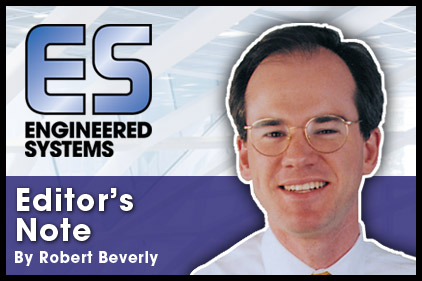The premise was the counter employee at the competition explaining to the concerned customer that its chicken sandwich wasn’t a chicken breast but was actually composed of “parts.” Which particular parts wasn’t important because, after all, “parts is parts.” And then employee #2 chimes in to report that all the various parts are “fused” into one big part, and then that’s cut up to make sandwiches. A funny and effective ad.
When it comes to buildings, the quality involved means that “parts is parts” doesn’t apply. But as owners, commissioning agents, and others know, even having an assembly of quality parts doesn’t ensure that all that goodness will transfer to the performance of the functioning whole building. (Sometimes, the culprit is installation — a key point made at the recent Danfoss EnVisioneering Symposium, see the story in this issue’s “Issues & Events.”)
Throw in new technologies hitting the marketplace, and there’s more hands-on uncertainty than ever regarding how different components will work in various combinations or circumstances. And how accurate are energy simulations in predicting these outcomes? As the press release by Julie Chao outlined, that’s where this test bed facility will come in.
“One can think of these test beds as kind of an erector set. They’re designed with extreme flexibility in mind,” said Berkeley Lab engineer Oren Schetrit, a program manager for the Test Bed Facility. “You’ll be able to change out the walls, windows, lighting, HVAC [heating, ventilation and air conditioning] system, external or internal shading and the configuration of the internal office systems. You can also lower or raise the ceiling height and floor height.”
With proper monitoring along with control over other factors such as building orientation, researchers should be able to simulate a host of real-life scenarios and permutations like never before. For an industry where almost no project wants to be the first to take the plunge on a new technology opportunity, this LBNL facility could increase the speed and assurance with which attractive design options start living up to their potential, while also revealing more effective ways to use existing strategies.
The facility is scheduled for completion in 2013. Better info in the name of better performance in thousands of chicken sandwiches buildings to follow shortly thereafter.
SHUFFLING PLATES
In other news, it turns out the West coast doesn’t have a monopoly in the U.S. when it comes to fun with tectonics. I was editing on a sunny Tuesday afternoon when the East coast got its biggest earthquake in over a century. As it turns out, the epicenter of the 5.8 quake was only about 30 minutes east of here, in tiny Mineral, VA. (With earthquakes on Tuesday and Hurricane Irene blowing up the coast on the weekend, I wondered if there was perhaps some time midweek to work in some locusts, but no.)
Of course, it reminded me of the seismic coverage last spring after the Japanese earthquake/tsunami disaster, and my April note in this space (“Aftershocks: Don’t Be Swayed). That was only months ago, but I admit the links and resources I listed in that column have an even fresher sense of relevance. Perhaps our East coast readers have thought the same thing. While the region was lucky that this event was nothing on the order of the devastation in Japan, it was certainly serious enough to bring seismic guidelines and precautions to the forefront.
You can find that “Editor’s Note,” along with the subsequent Steve Liescheidt seismic feature, on our newly redesigned website. For the time it takes to register, you’ll have permanent access to our full archive of features, columns, etc. You never know when one might become more relevant than you had imagined. ES


